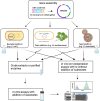Stressing the importance of plant specialized metabolites: omics-based approaches for discovering specialized metabolism in plant stress responses
- PMID: 38023861
- PMCID: PMC10663375
- DOI: 10.3389/fpls.2023.1272363
Stressing the importance of plant specialized metabolites: omics-based approaches for discovering specialized metabolism in plant stress responses
Abstract
Plants produce a diverse range of specialized metabolites that play pivotal roles in mediating environmental interactions and stress adaptation. These unique chemical compounds also hold significant agricultural, medicinal, and industrial values. Despite the expanding knowledge of their functions in plant stress interactions, understanding the intricate biosynthetic pathways of these natural products remains challenging due to gene and pathway redundancy, multifunctionality of proteins, and the activity of enzymes with broad substrate specificity. In the past decade, substantial progress in genomics, transcriptomics, metabolomics, and proteomics has made the exploration of plant specialized metabolism more feasible than ever before. Notably, recent advances in integrative multi-omics and computational approaches, along with other technologies, are accelerating the discovery of plant specialized metabolism. In this review, we present a summary of the recent progress in the discovery of plant stress-related specialized metabolites. Emphasis is placed on the application of advanced omics-based approaches and other techniques in studying plant stress-related specialized metabolism. Additionally, we discuss the high-throughput methods for gene functional characterization. These advances hold great promise for harnessing the potential of specialized metabolites to enhance plant stress resilience in the future.
Keywords: biosynthesis; biotic and abiotic stress; metabolomics; multi-omics; plant specialized metabolites.
Copyright © 2023 Wu, Northen and Ding.
Conflict of interest statement
The authors declare that the work was conducted in the absence of any commercial or financial relationships that could be construed as a potential conflict of interest.
Figures



Similar articles
-
Genomics-enabled analysis of specialized metabolism in bioenergy crops: current progress and challenges.Synth Biol (Oxf). 2020 Jun 1;5(1):ysaa005. doi: 10.1093/synbio/ysaa005. eCollection 2020. Synth Biol (Oxf). 2020. PMID: 32995549 Free PMC article. Review.
-
Integrated omics analysis of specialized metabolism in medicinal plants.Plant J. 2017 May;90(4):764-787. doi: 10.1111/tpj.13485. Epub 2017 Mar 30. Plant J. 2017. PMID: 28109168
-
The Current Developments in Medicinal Plant Genomics Enabled the Diversification of Secondary Metabolites' Biosynthesis.Int J Mol Sci. 2022 Dec 14;23(24):15932. doi: 10.3390/ijms232415932. Int J Mol Sci. 2022. PMID: 36555572 Free PMC article. Review.
-
Enhancement of Plant Productivity in the Post-Genomics Era.Curr Genomics. 2016 Aug;17(4):295-6. doi: 10.2174/138920291704160607182507. Curr Genomics. 2016. PMID: 27499678 Free PMC article.
-
From single- to multi-omics: future research trends in medicinal plants.Brief Bioinform. 2023 Jan 19;24(1):bbac485. doi: 10.1093/bib/bbac485. Brief Bioinform. 2023. PMID: 36416120 Free PMC article.
Cited by
-
Unveiling the aesthetic secrets: exploring connections between genetic makeup, chemical, and environmental factors for enhancing/improving the color and fragrance/aroma of Chimonanthus praecox.PeerJ. 2024 Apr 19;12:e17238. doi: 10.7717/peerj.17238. eCollection 2024. PeerJ. 2024. PMID: 38650650 Free PMC article. Review.
-
Omics-Driven Strategies for Developing Saline-Smart Lentils: A Comprehensive Review.Int J Mol Sci. 2024 Oct 22;25(21):11360. doi: 10.3390/ijms252111360. Int J Mol Sci. 2024. PMID: 39518913 Free PMC article. Review.
-
Integrative physiological, transcriptomic, and metabolomic analysis of Abelmoschus manihot in response to Cd toxicity.Front Plant Sci. 2024 Jun 10;15:1389207. doi: 10.3389/fpls.2024.1389207. eCollection 2024. Front Plant Sci. 2024. PMID: 38916029 Free PMC article.
References
-
- Bach S. S., Bassard J. E., Andersen-Ranberg J., Moldrup M. E., Simonsen H. T., Hamberger B. (2014). High-throughput testing of terpenoid biosynthesis candidate genes using transient expression in Nicotiana benthamiana . Methods Mol. Biol. 1153, 245–255. doi: 10.1007/978-1-4939-0606-2_18 - DOI - PubMed
-
- Barnes P. W., Tobler M. A., Keefover-Ring K., Flint S. D., Barkley A. E., Ryel R. J., et al. . (2016). Rapid modulation of ultraviolet shielding in plants is influenced by solar ultraviolet radiation and linked to alterations in flavonoids. Plant Cell Environ. 39 (1), 222–230. doi: 10.1111/pce.12609 - DOI - PubMed
Publication types
Grants and funding
LinkOut - more resources
Full Text Sources
Miscellaneous

